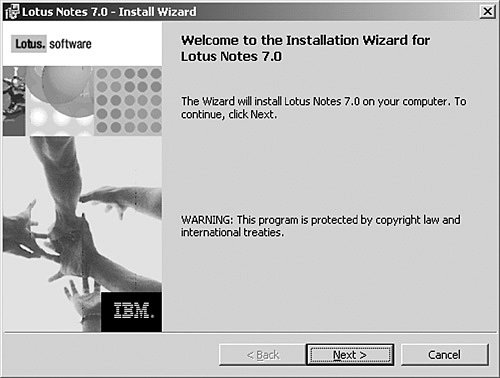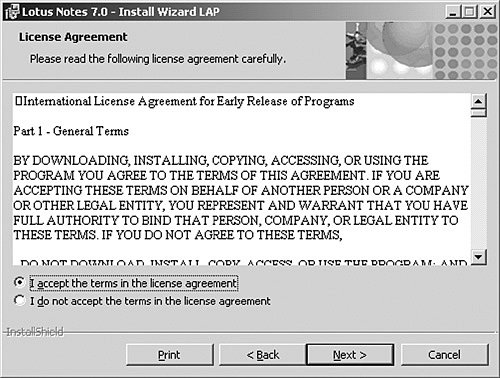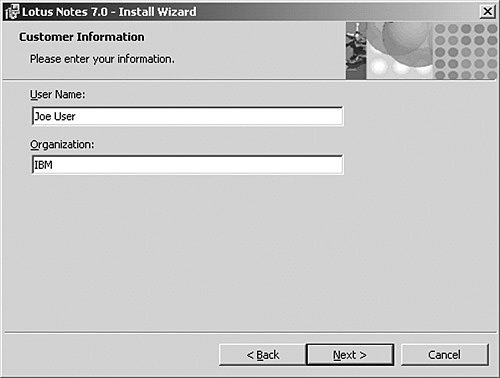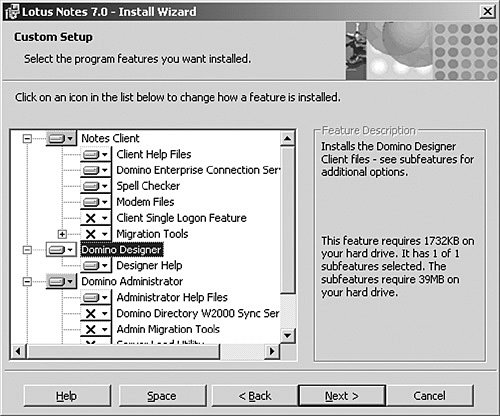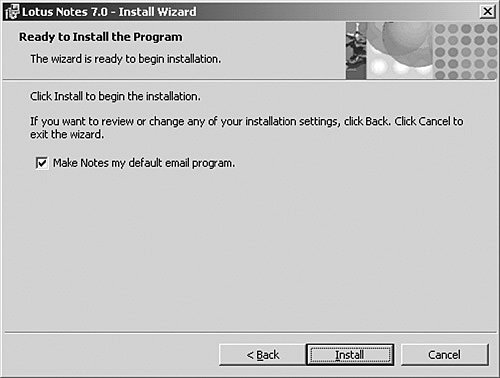Installing the Designer Client
Installing the Designer client is simple and can usually be completed in minutes. This section will summarize the installation process for Designer on a Microsoft Windows PC.
Note
You can download a free trial version of the Domino Designer client from the Lotus Web site. See the developerWorks Web link information at the end of this chapter.
|
A.2.1 |
These instructions are intended to be a brief summary for version 7.0 of the Designer client for Microsoft Windows®. Although the instructions, for the most part, are the same across versions, users should follow the instructions provided by Lotus when working with other versions or operating systems. Let's briefly review the system setup requirements.
Supported Microsoft Windows Platforms
- Microsoft® Windows® 98
- Microsoft® Windows® NT, Version 4.0
- Microsoft® Windows 2000® Professional
- Microsoft® Windows XP® Professional
Memory Requirements
- For Windows 98Minimum of 64MB RAM (128MB recommended)
- For Windows NTMinimum of 64MB RAM (128MB recommended)
- For Windows 2000Minimum of 128MB RAM (256MB recommended)
- For Windows XPMinimum of 128MB RAM (256MB recommended)
Disk Space Requirements
- 2MB for the Designer client
- 39MB for the Designer client help files
- Space for general application development
Before starting the installation process, you'll want to close all applications running on the Desktop. This is especially important if any Lotus products are running. Many Lotus products share files and could affect the installation process if they are running while installing the Designer application.
If you already have the Lotus Notes client installed, you'll want to back up a couple files. Make a copy of these files and store them in a different directory (or change the extension of the copied file to .BAK to store in the same directory). These files contain configuration information and could be overwritten during the installation process.
- NOTES.INI This file contains preferences for the Notes client application and is typically stored either in the C:WinNT or the C:LotusNotes directory.
- NAMES.NSF This file contains contact names, addresses, certificates, connection and location information and is typically stored in the C:LotusNotesData directory.
- DESKTOP.DSK This file contains preferences for the look and feel of your Lotus Notes workspace. This file is typically stored in the C:LotusNotesData directory. Note: Depending on the version installed, this file may be named desktop5.dsk or desktop6.dsk.
- USER.ID File This file identifies each person using Lotus Notes (where user represents a person's name). It contains your certificate keys, name, and password information. This file is typically stored in the c:LotusNotesData directory.
To install the Lotus Domino Designer, follow these steps. Readers should install the Lotus Notes client and obtain a valid user ID file and password prior to performing these steps.
|
1. |
Insert the Lotus Designer CD-ROM into the computer. If your computer is set up to auto-launch, the installation routine will start automatically. If the installation program does not start, click the Start button and choose Run from the Windows Desktop. Then enter the command drive:setup.exe (for example, d:setup.exe) and press Enter. Figure 2.1. Domino Designer InstallShield startup
|
|
2. |
A general welcome and installation wizard startup window will be displayed (see Figure 2.2). Click Next to continue the installation. Figure 2.2. Domino Designer Install Wizard
|
|
3. |
Carefully read the license agreement (see Figure 2.3). If you agree to the terms, click the I accept the terms in the license agreement radio button and click Next to continue. Figure 2.3. Domino Designer License Agreement
|
|
4. |
Specify your name and organization; for example, Joe User and IBM (see Figure 2.4). These fields can contain any text string and will not affect the installation of the Lotus products. Click Next to continue. Figure 2.4. Domino Designer Customer Information
|
|
5. |
Accept the default installation directory (which should be C:LotusNotes) and click Next to continue. Tip Multiple versions of Lotus Notes, Designer, and Administrator can be installed on a workstation. Simply change the default installation location to have multiple software levels installed. Installing in an alternate directory will enable you to run two separate versions of the Lotus software. Refer to the installation manual provided with the Lotus products for additional information. |
|
6. |
At the installation options dialog, make sure the Domino Designer option is enabled. Options marked with an X will not be installed. Verify that the installation screen is similar to Figure 2.5. Figure 2.5. Domino Designer Install Options
If these items are not selected, click on the triangle to the left of the Domino Designer and Designer Help options. Select This feature will be installed on the local hard drive to install each of these features. Click Next to continue. |
|
7. |
The Ready to Install the Program dialog will display (see Figure 2.6). Click Install. Figure 2.6. Domino Designer Ready to Install Confirmation
|
|
8. |
When the installation is complete, Lotus displays the Installation Complete dialog box. Click Finish to return to the Microsoft Windows Desktop. Congratulations, setup is now complete! |
An Introduction to the Lotus Domino Tool Suite
Getting Started with Designer
- Getting Started with Designer
- Installing the Designer Client
- Launching the Designer Client
- Creating My First Notes Database
- Links to developerWorks
Navigating the Domino Designer Workspace
- Navigating the Domino Designer Workspace
- An Introduction to Designer
- The Design Pane
- The Work Pane
- The Object Pane
- The Programmers Pane
- The Action Pane
- Design Tabs
- Language Selector
- Client and Browser Selector
- Status Bar
- Links to developerWorks
Domino Design Elements
- Domino Design Elements
- Building Blocks of a Notes Database
- Naming Design Elements
- Working with Forms
- Working with Fields
- Working with Layout Regions
- Working with Sections
- Working with Buttons
- Working with Views
- Working with Application Menus
- Working with Folders
- Working with Framesets
- Working with Pages
- Working with Shared Code
- Working with Shared Resources
- Links to developerWorks
An Introduction to Formula Language
- An Introduction to Formula Language
- What Is Formula Language?
- What Is a Formula?
- Working with Variables
- Formula Language Keywords
- Working with Operators
- General Syntax Rules
- What Are Functions and Commands?
- What Are Commands?
- Working with Text Strings
- Working with Conditional Branching
- Working with Iterative Loops
- Working with Lookup Functions
- Working with Dates
- Working with Lists
- Working with User Prompts
- Links to developerWorks
An Introduction to LotusScript
- An Introduction to LotusScript
- Introduction to Object-Oriented Programming
- LotusScript Classes
- Keywords
- Variables
- Constants
- Operators
- Comments
- Defining Variables and Constants
- Defining Object Reference Variables
- Working with Conditional Branching
- Working with Iterative Loops
- Communicating with Users
- Working with Arrays
- Using Formula Language in LotusScript Code
- Compiling LotusScript Code
- Links to developerWorks
Fundamentals of a Notes Application
- Fundamentals of a Notes Application
- The Five Primary Application Types
- The Application Development Life Cycle
- Elements of a Project Plan
- Elements of a Project Schedule
- Questions to Ask When Designing a Database
- Designing a Notes Application
- Links to developerWorks
Calendar Applications
- Calendar Applications
- Application Architecture
- Managing Recurring Events Using Single Documents
- Managing Recurring Events Using Multiple Documents
- Project A: Build an Event Calendar
- Project B: Build a Conference Room Reservation System
- Links to developerWorks
Collaborative Applications
- Collaborative Applications
- Project A: Build a Discussion Forum
- Project B: Build a Project Control Notebook
- Links to developerWorks
Reference Library Applications
- Reference Library Applications
- Project A: Build a Connection Document Database
- Project B: Build a Spreadsheet Generator
Workflow Applications
- Workflow Applications
- Defining a Workflow Application
- Project: Building a Workflow Database
- Links to developerWorks
Web Applications
- Web Applications
- Defining a Web Application
- Project: Building a Domino Web Site
- Security
- Troubleshooting
- Links to developerWorks
Design Enhancements Using LotusScript
- Design Enhancements Using LotusScript
- Custom LotusScript Functions and Routines
- Compare Two Dates
- Check for an Element in an Array
- Replace an Element in an Array
- Remove a Character from a String
- Remove an Element from an Array
- Compare Two Arrays
- Working with Dynamic Arrays
- Create a Custom Popup Dialog Box
- Refresh a Document from the User Interface
- Search for a Document
- Working with Dates and Times
- Compute the Day of the Week
- How to Reference $ Fields
- How to Set the ReturnReceipt for LotusScript-Generated Email
- Add Field Validation to a Form
- Display an Are You Sure? Message
- Format a Users Name
- Automatically Update a History Field When a Document Changes
- Prompt the User to Describe Document Changes and Update the History Log
- Create a Unique Document Record Number
- Limit the Ability to Create Documents on a Local Database
- How to Zero Pad a Text Number
- How to Add Text to a Rich Text Object
- How to Attach a File to a Rich Text Object
- How to Format Text in a Rich Text Object
- Change Document to Edit Mode
- Obtain the Current Roles Assigned to a User
- Generate a Document in Another Database
- Generate a New Document by Duplicating an Existing Document
- Prompt in LotusScript
- Sending Email to Multiple Recipients Using LotusScript
- Add a View Icon and Mood Stamp to an Email
- Retrieve and Update NOTES.INI Environment Values
- Assign One Rich Text Object to Another Rich Text Object
- Add a Document, View, or Database Link to a Rich Text Field
- Create a Button to Add a Calendar Event
- Links to developerWorks
Design Enhancements Using Formula Language
- Design Enhancements Using Formula Language
- Formula Language Enhancements
- Compare Two Lists
- Expand and Collapse All Document Sections
- Expand and Collapse All View Categories
- Get the Current Day of the Week
- Get the Current Month of the Year
- Create a Formatted Date String
- Create an Attach File Button
- Display the Windows File Finder Dialog
- Create a New Document
- Create a Last Updated By Field
- Create a Last Modified On Date Stamp
- Format a Users Name
- Hide Text and Design Elements Based on a Users Role
- Working with @DBColumn
- Working with @DBLookup
- Parse a Text String
- How to Format Field Values Using Input Translation
- How to Add Field Validation
- Display an Are You Sure? Warning Message
- Generate Email Using Formula Language
- How to Sort a List of Values
View Enhancements
- View Enhancements
- Create a New Document by Double-Clicking on a Calendar Date
- Display Documents in a View by Year and Month
- Display an Icon in a View
- Retrieve All Views in a Database
- Retrieve All Columns in a View
- Retrieve All Columns for Each View in a Database
- How to Manage Conflict Documents
- Display All Documents by Form Name
- Disable the Ability to Paste Documents into a View
- Links to developerWorks
Sample Agents
- Sample Agents
- Agent Enhancements
- Simple Action Agent to Modify All Documents
- LotusScript Agent to Modify All Documents Containing a Specific Field Value
- Agent to Manually Generate an Email Report
- Schedule Agent to Send a Daily, Weekly, or Monthly Email Report
- Links to developerWorks
Miscellaneous Enhancements and Tips for Domino Databases
- Miscellaneous Enhancements
- Disable the Ability to Print, Copy, Cut, and Forward Documents
- Using Field Hints on a Form
- Using Static Popups to Display Help Messages
- How to Inherit Fields Between Forms
- Add an Icon to an Action Button
- Create a Custom Application Interface
- How to Set the Field Tab Order on a Form
- Domino Shortcut Keys
Data Management
- Data Management
- Importing Data
- Exporting Data
- Migrating Data
- Creating Tables
- Modifying Data Using a LotusScript Agent
- Archiving Data Using an Agent
- Refreshing All Documents
Security
- Security
- Access Control List Fundamentals
- Managing Database Access
- How to Enforce Consistent ACL Settings Across Replicas
- Encrypt the Database
- Managing Access to Views
- Managing Access to Forms and Documents
- Managing Access to Fields
- Managing Access to Source Code
- Hiding a Database Design
- Hiding a LotusScript Library
- How to Sign a Database
- How to Cross Certify Domino Servers
- Links to developerWorks
Application Deployment and Maintenance
- Application Deployment and Maintenance
- What Are Templates?
- Establishing a Development Environment
- Migrating a Database Design
- Preserve a Copy of the Database Design
- Deploying the Production Database
- The Importance of Database Backups
- Process Synopsis
- Links to developerWorks
Troubleshooting
- Troubleshooting
- Troubleshooting LotusScript
- Troubleshooting Agents
- Common Database Problems
- Where to Find Additional Assistance
- Links to developerWorks
Appendix A. Online Project Files and Sample Applications
- Appendix A. Online Project Files and Sample Applications
- About the Online Materials
- About the Companion Web Site
- About the Development Tools and Files Folder
- Installing a Notes Database
Appendix B. IBM® Lotus® Notes® and Domino®Whats Next?
EAN: 2147483647
Pages: 293


